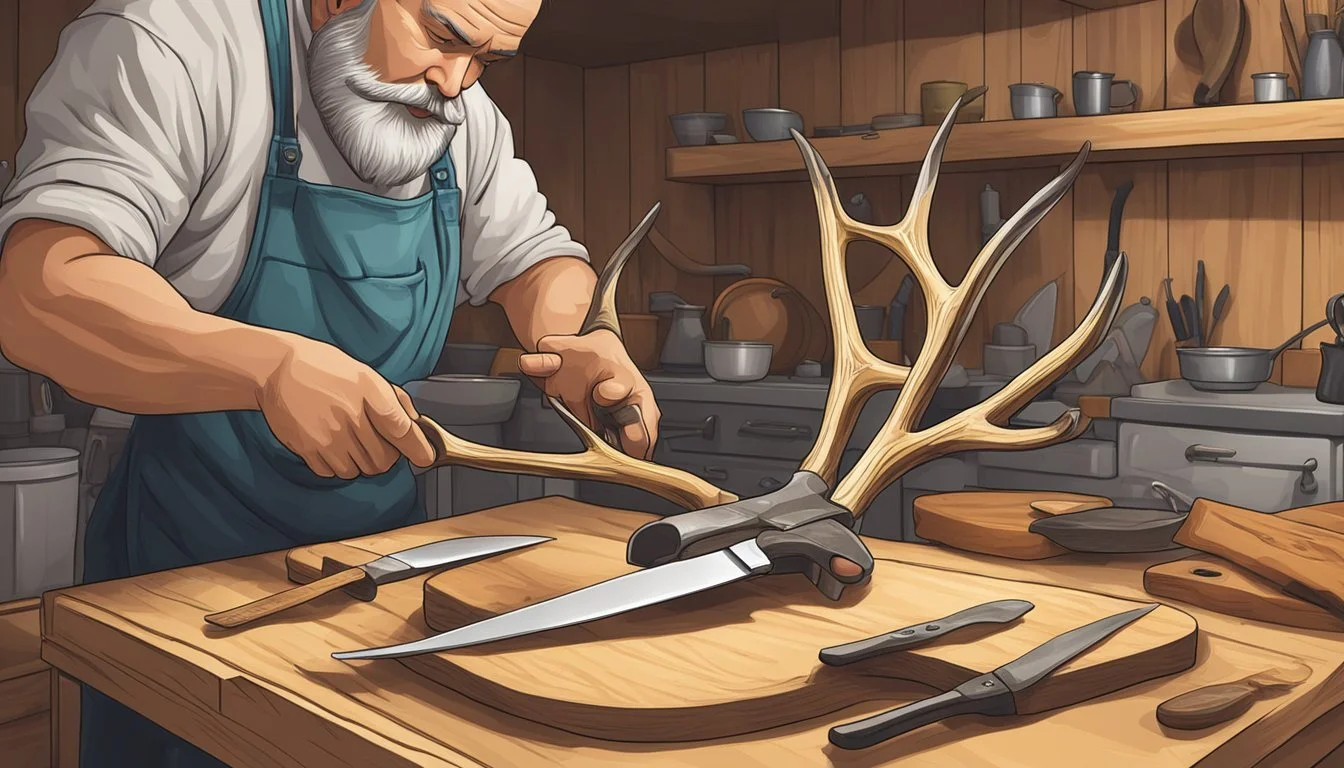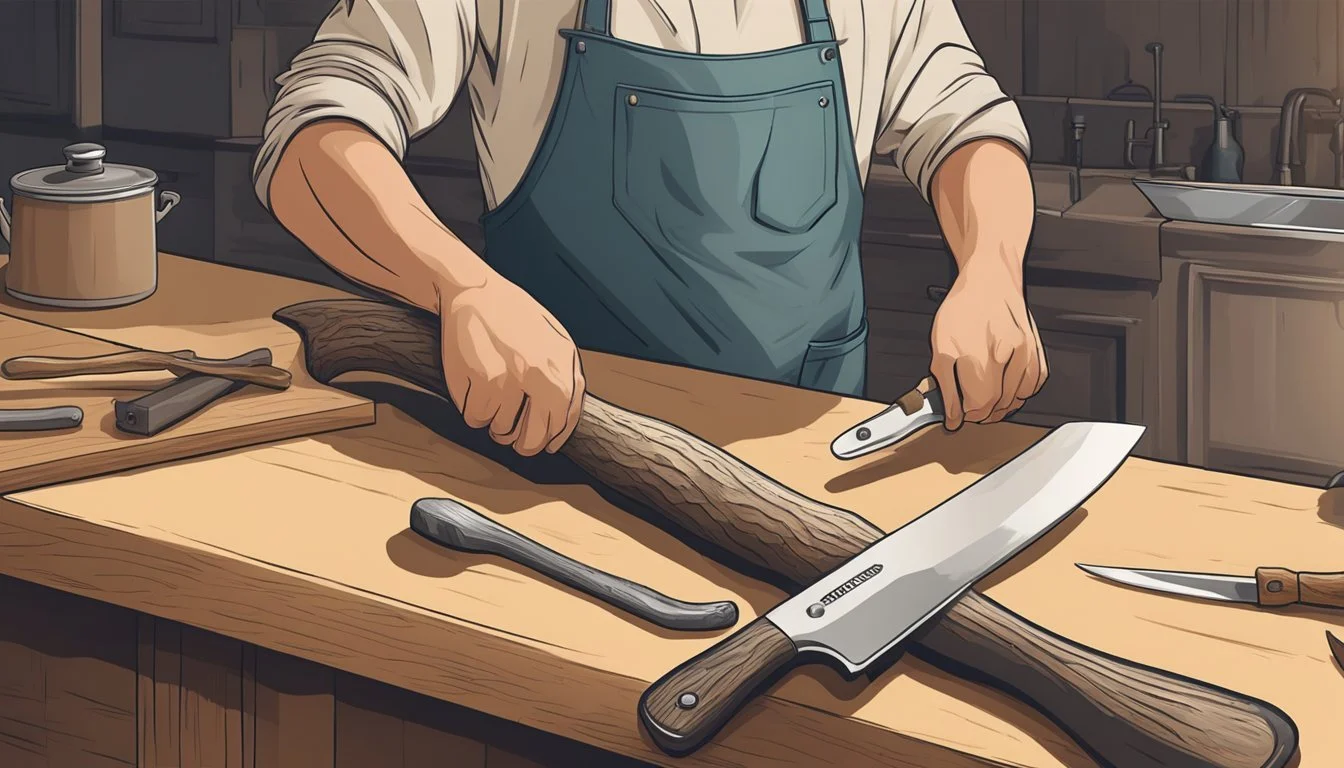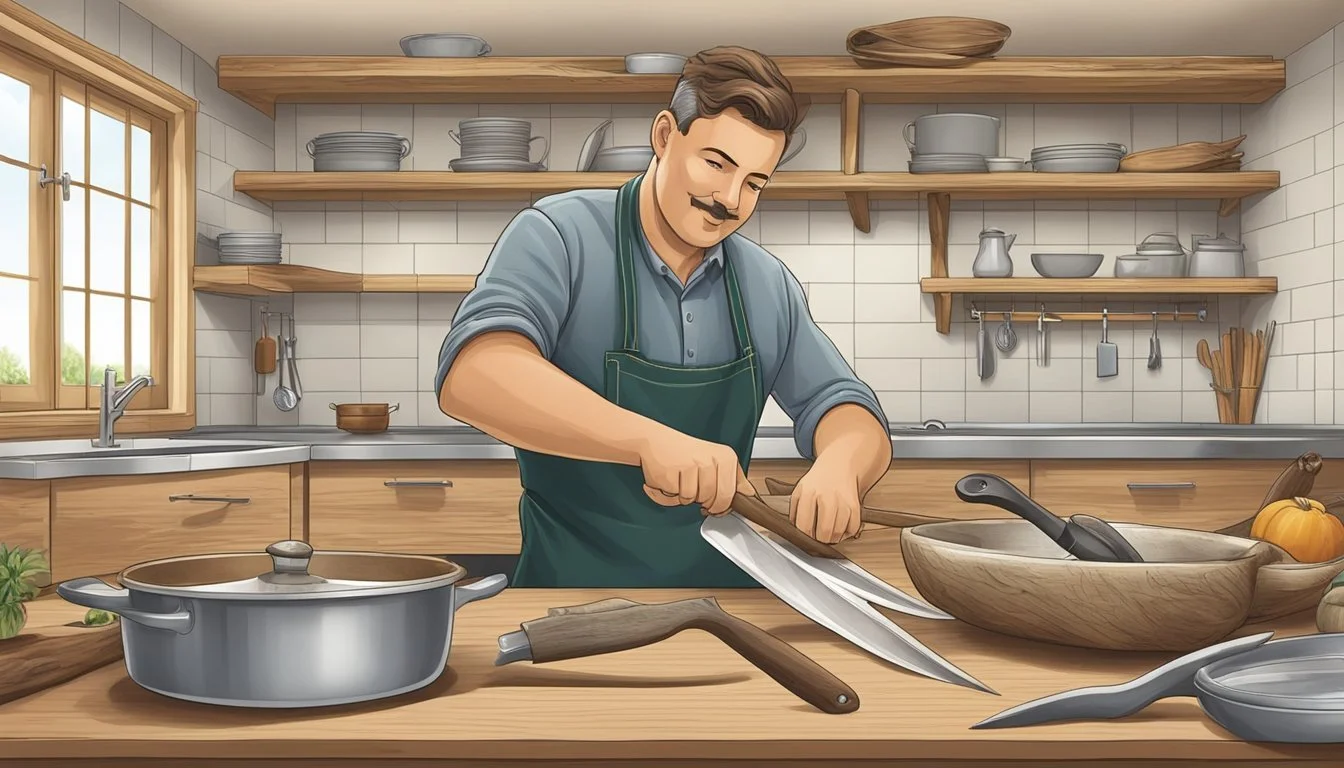The Art of Making Deer Antler Handles
Craftsmanship for Unique Kitchen Knives
Crafting knife handles from deer antler merges tradition with modern culinary needs, creating durable and aesthetically pleasing household items. Deer antler has been valued for its strength and beauty, attributes that make it ideal for knife handles. These handles are not only striking in appearance but also provide a comfortable grip for the precision required in kitchen tasks. Artisans and enthusiasts appreciate the natural patterns and ridges that ensure no two antler handles are identical, making each knife truly unique.
The process of making a knife handle from deer antler involves several steps, each requiring attention to detail and craftsmanship. Antler handles can be fashioned to fit various types of knives, from small paring knives to large chef's knives, each meeting the ergonomic needs of the user. Adding a custom leather sheath complements the rustic elegance of the antler handle, providing protection for the blade and a complete presentation of the knife as both a tool and a work of art.
Incorporating deer antler handles into kitchen knives transforms an ordinary utensil into a conversation piece, merging form and function. Chefs and home cooks alike can appreciate the balance, grip, and comfort that a well-crafted antler handle provides. With proper care, these handles can survive years of rigorous kitchen use, making them a sustainable choice for those looking to integrate a piece of nature into their culinary practices.
Understanding Deer Antler Material
When selecting deer antler for kitchen knife handles, one must consider its inherent characteristics and identify high-quality material for a durable and aesthetically pleasing outcome.
Characteristics of Deer Antler
Deer antlers offer a unique combination of strength and durability which makes them suitable for knife handles. Antlers are naturally shed by stags and are not to be confused with horns, which are permanent. The primary component of antler is bone, giving it a rigid structure. However, antlers also contain a porous layer and a pithy core, which provide a lighter weight and some degree of resilience.
Rigidity: Provides excellent stability, essential for knife handles
Durability: Can withstand the wear and tear of kitchen use
The outer layer of the antler is solid and suitable for carving and shaping, whereas the inner pithy portion tends to be softer and may detract from the handle's strength if not properly managed during the crafting process.
Identifying Quality Antler
A high-quality antler for knife handles is typically dense and free of large pores. The presence of a pithy core is natural, but it should not be overly expansive, as this can compromise the integrity of the handle. Antlers with a relatively small pith and more dense material are preferable.
Selection Criteria:
Minimal pitting and porousness
Solid outer layer with minimal cracks or defects
A small, compact pithy core
When selecting antler pieces, one should look for sections closer to the base, often known as the burr, where the material tends to be the densest. The density of these parts supports a strong and stable handle, making them ideal for kitchen knife fabrication.
Preparation of Antler for Handle Making
The creation of a kitchen knife handle from deer antler begins with meticulous preparation. This involves cleaning the antler, cutting it to the precise size, and carefully drilling a hole for the tang.
Cleaning and Sanding the Antler
Initially, the artisan cleans the antler using soapy water and a brush to remove all dirt and debris. Once clean, the antler must be sanded. They start with coarse-grit sandpaper to remove the rough outer layer, then progressively move to finer grits to achieve a smooth surface. Sanding is essential for both aesthetics and securing a good bond with adhesives during assembly.
Cutting the Antler to Size
After cleaning and sanding, the antler is ready to be cut. They secure the antler in a vise to ensure stability and use a saw, preferring a hacksaw or coping saw for precision. The ideal piece is usually an antler tine, which provides a natural grip shape. The cut determines the length of the handle, which they tailor to the knife blade and the user's hand.
Drilling the Tang Hole
The final preparation step involves drilling a hole for the knife tang. They secure the antler segment once more in a vise. Using a drill equipped with an appropriately sized drill bit, they carefully drill into the antler where the tang will fit. They may use an angle grinder to widen or shape the hole if necessary, ensuring a snug fit for the blade. The drilling process must be precise to maintain the handle's strength and balance.
By adhering to these specific preparation steps, the maker builds a solid foundation for a durable and aesthetically pleasing deer antler handle for kitchen knives.
Designing the Knife Handle
Creating a kitchen knife handle from deer antler involves meticulous craftsmanship and a deep understanding of design. One must consider both aesthetic appeal and functionality.
Defining the Handle Shape
The initial stage in designing the handle is to outline the desired shape. A craftsman typically sketches the profile on the antler, accommodating the natural curve for an organic feel. Precision is key when cutting the antler to form; a coping saw with raw saw blades can effectively carve out the rough silhouette.
Ergonomics and Grip Considerations
A handle must conform comfortably to the user's hand, necessitating careful consideration of ergonomics. The designer shapes the handle, ensuring the grip is both secure and comfortable. Carving tool options include a file for detailed subtraction and smoothing of the grip surface. The internal structure of the antler is softer and allows for easier manipulation to perfect the ergonomic shape that aligns with the hand's natural grip.
Assembling the Handle
Assembling the deer antler handle onto a kitchen knife involves careful alignment of the handle with the blade's tang and securing them together. Precision in drilling and proper application of adhesives are crucial for a durable and functional knife handle.
Attaching the Handle to the Blade
First, a craftsperson aligns the antler handle with the blade's tang—the pronged metal part to be inserted into the handle. For round tangs, the hole within the antler must match the tang's diameter, whereas a hidden tang will necessitate a slot that conforms to its shape. The blade-and-guard assembly is then placed against the antler to mark the exact drilling location. If using a hidden tang, they begin with a small pilot hole before gradually enlarging it to accommodate the tang's width and shape.
Securing with Pins and Glue
Once the tang fits snugly into the drilled hole, the next step is to ensure the secure attachment of the blade to the handle. Epoxy resin is commonly used for its strong bonding properties. The craftsperson applies it to the tang and inside the hole before insertion. To increase the handle's stability, pins may be inserted through pre-drilled holes that align through the antler and tang. These pins are also coated with epoxy before being driven in, and excess glue is wiped away. The glue must then cure fully, which typically takes around 24 hours, to ensure a strong, permanent bond.
Finishing the Deer Antler Handle
Proper finishing of a deer antler handle enhances both its durability and aesthetic appeal. This involves meticulous polishing to remove any scratches and sealing it to protect against moisture and wear.
Polishing and Smoothing
One begins by using sandpaper with increasing grits to smoothly polish the antler. The process starts with a coarser grit to remove any larger imperfections and then transitions to finer grits for a smooth finish. They should sand in the same direction as the antler's natural lines to maintain its integrity and visual flow. The goal is to eliminate scratches and rough patches until the surface feels smooth to the touch.
Sealing with Oil or Resin
After polishing, one seals the antler handle to preserve its appearance and protect it from the rigors of kitchen use. Two common sealants are natural oil and resin:
Natural Oil: He applies a small amount of food-safe oil, such as mineral oil, to a clean cloth and rubs it into the antler in a circular motion. This not only seals but also brings out the natural colors of the antler.
Resin: She may choose to apply a thin coat of epoxy resin for a durable finish. It is important to apply the resin evenly to prevent drips or bumps. The resin needs to cure according to the manufacturer's specifications.
In both cases, one must ensure complete coverage to effectively seal the antler against moisture and everyday kitchen stains.
Knives with Antler Handles and their Uses
Antler-handled knives serve both aesthetic and functional purposes, with distinct types suited to various applications.
Types of Knives with Antler Handles
Knives sporting handles made from deer antlers come in several forms. Hunting knives are the most prevalent, designed with robust blades for field dressing game. Kitchen knives include chef's knives, paring knives, and others, often preferred for their unique texture and grip. Custom knives may vary in blade shape and size, tailored to specific tasks or decorative preferences. Here's a concise list of commonly found deer antler handle knives:
Hunting Knives: Designed to withstand the rigors of outdoor use.
Kitchen Knives: Crafted for culinary precision and unique kitchen aesthetics.
Custom Knives: Each presents a one-of-a-kind design, frequently used for display or specific cutting tasks.
Hunting and Utility Knife Applications
Hunting knives with antler handles typically have a sturdy knife blade, proving essential for hunters during the field dressing process. Sharpness and durability define their utility in cutting through hide and bones with precision.
Utility knives adapt to everyday tasks, ranging from simple cutting chores to more demanding work like carving wood. They are valued for their multipurpose nature and are often a favorite choice for those appreciating a combination of form and function.
In both cases, the deer antler knife handle provides a superior grip due to the natural texture of the antler, enhancing control during intricate tasks or when under the duress of outdoor elements.
Protecting and Maintaining Antler Handled Knives
Proper protection and maintenance are crucial for preserving the functionality and appearance of knives with deer antler handles. A well-crafted sheath and routine care will ensure these knives remain sharp, safe, and stunning for years to come.
Creating Custom Sheaths
A custom leather sheath not only shields the blade but also adds a personal touch to the knife. They should tailor the sheath to fit the knife's specific dimensions, considering both the blade and the antler handle. Using durable, high-quality leather not only protects the knife from environmental elements but also from incidental impacts. A snug fit prevents the knife from moving inside the sheath, which might otherwise cause damage to the antler handle.
To construct an effective leather sheath:
Measure the blade and handle accurately.
Cut the leather to create the sheath body and belt loop.
Stitch the sides securely, reinforcing the thread for longevity.
Mold the leather when wet around the knife for a custom fit, ensuring it dries thoroughly to retain its shape.
Knife Care and Sharpening Tips
Regular maintenance extends the life of both the blade and the antler handle. It's important to clean the knife after each use, ideally with a mild soap and water, followed by thorough drying. Moisture can be detrimental to the antler material, leading to potential cracks or degradation.
Sharpening the knife not only keeps the blade efficient but also reduces the risk of accidents that may occur with a dull blade. It's advisable to employ a sharpening stone or rod that matches the blade's requirements and to always follow the existing angle of the blade's edge.
Care tips include:
Avoid dishwashers; the chemicals and heat can damage both the blade and the antler handle.
Oil the antler handle occasionally to preserve its luster and prevent drying out.
Protect the bolster, if present, by applying a metal polish to prevent tarnishing.
For those selling antler handled knives, providing care instructions to customers is an added value that emphasizes the artisanal quality of the knife and conveys a commitment to craftsmanship and customer satisfaction.






